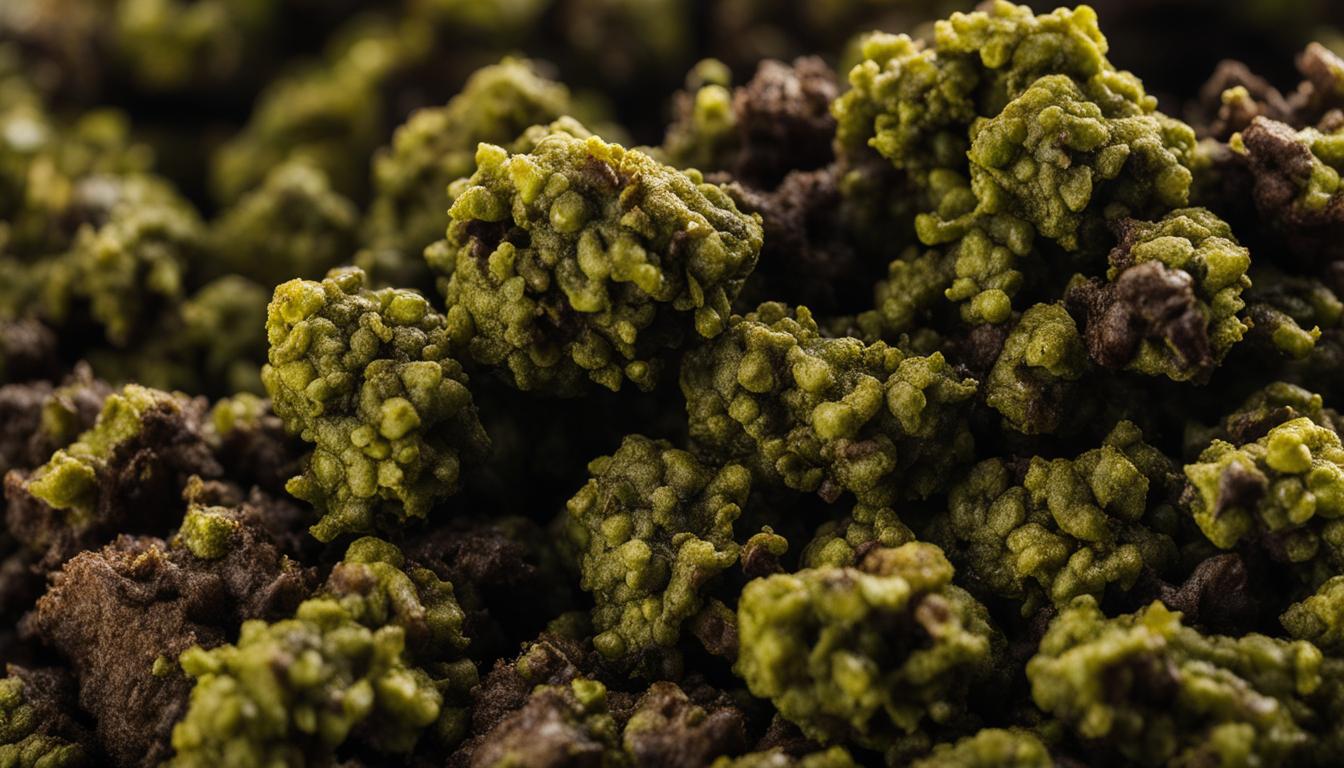Dogs can develop bladder stones, also known as uroliths or cystic calculi, which are mineral formations in the urinary bladder. These stones can vary in size and composition, causing discomfort and potential complications for our furry friends. Recognizing the causes and taking appropriate care is crucial for ensuring their well-being.
Key Takeaways:
- Bladder stones, or uroliths, can form in the urinary bladder of dogs and vary in size and composition.
- Symptoms of bladder stones can include blood in the urine and straining to urinate.
- The causes of bladder stones in dogs can be elevated levels of certain compounds in the urine, bacterial infections, dietary factors, and metabolic issues.
- Diagnosis of bladder stones is usually done through radiographs or ultrasounds.
- Treatment options for bladder stones include surgical removal, non-surgical removal, or dietary dissolution.
What are Bladder Stones?
Bladder stones, also known as uroliths or cystic calculi, are rock-like formations of minerals that develop in the urinary bladder of dogs. They can vary in size from sand-like grains to gravel. Bladder stones can be a single large stone or a collection of smaller stones. They are formed due to disease or inflammation in the urinary bladder. Bladder stones can cause symptoms such as blood in the urine and straining to urinate. They can be composed of different minerals, and a mixture of small and large stones is commonly observed.
Bladder stones, or uroliths, form when minerals in the urinary bladder solidify and clump together. They can range in size from barely visible sand-like grains to larger gravel-like masses. These mineral formations can be a single large stone or a cluster of smaller stones.
The formation of bladder stones is typically a result of disease or inflammation in the urinary bladder. Various factors, such as elevated levels of certain compounds, urinary tract infections, dietary factors, and metabolic issues, can contribute to their development. The composition of bladder stones may vary, with different minerals and crystals combining to form them.
Bladder stones can cause significant discomfort and distress to dogs. They can irritate the bladder wall and lead to symptoms like blood in the urine and straining to urinate. The presence of bladder stones can also increase the risk of urinary obstruction, a potentially life-threatening emergency.
During diagnosis, veterinarians may conduct radiographs, ultrasounds, or palpations to detect and assess the size and composition of the bladder stones. Treatment options for bladder stones include surgical removal, non-surgical removal using techniques like urohydropropulsion, and dietary dissolution. Prevention of bladder stones involves understanding the underlying causes, maintaining a proper diet, and ensuring adequate hydration and monitoring.
“Bladder stones, also known as uroliths or cystic calculi, are rock-like formations of minerals that develop in the urinary bladder of dogs.”
Bladder stones are a common condition that can affect dogs of all ages and breeds. Understanding the nature of bladder stones and their potential impact on canine health is crucial for dog owners and veterinary professionals alike.
| Key Points |
|---|
| Bladder stones are rock-like formations of minerals that develop in the urinary bladder of dogs. |
| They can vary in size, ranging from sand-like grains to larger gravel-like stones. |
| Bladder stones can be a single large stone or a cluster of smaller stones. |
| They are formed due to disease or inflammation in the urinary bladder. |
| Bladder stones can cause symptoms such as blood in the urine and straining to urinate. |
| The composition of bladder stones can vary, with different minerals and crystals contributing to their formation. |
Causes of Bladder Stones in Dogs
Bladder stones in dogs can develop due to various factors, including elevated levels of compounds in the urine, bacterial infections, dietary factors, and metabolic issues. The most commonly accepted theory is the Precipitation-Crystallization Theory, which explains that certain stone-forming compounds in the urine become elevated, leading to their precipitation and crystallization. This can occur as a result of dietary factors, previous bladder disease or infection, and even metabolic issues.
Bacterial infections in the bladder, especially those that produce an enzyme called urease, can significantly increase the risk of bladder stone formation. This enzyme can alter the composition of the urine, promoting the formation of crystals and subsequent stone formation. The exact cause of bladder stones may vary from case to case, and it is often a combination of multiple factors.
To better understand the causes of bladder stones in dogs, it is essential to explore the contributing factors in more detail. Here are the key causes:
Dietary Factors:
Dietary factors play a critical role in the development of bladder stones. Certain types of food can increase the concentration of stone-forming compounds in the urine, making it more susceptible to stone formation. Diets high in minerals such as calcium, oxalate, and magnesium can contribute to the formation of bladder stones. Additionally, an imbalanced diet or overconsumption of certain nutrients can affect the pH and mineral balance in the urine, promoting stone formation.
Bacterial Infections:
Bacterial infections in the urinary tract can be a significant risk factor for bladder stone formation. Infections caused by bacteria that produce urease are particularly concerning. Urease is an enzyme that breaks down urea into ammonia, which raises the pH of the urine. The alkaline environment created by urease-producing bacteria promotes the formation of certain types of bladder stones, such as struvite stones.
Elevated Levels of Compounds in Urine:
Elevated levels of certain compounds in the urine can contribute to the development of bladder stones. Increased concentrations of minerals, such as calcium, oxalate, struvite, and uric acid, can lead to the formation of crystals that eventually develop into stones. Factors that influence these compound levels include diet, genetics, underlying health conditions, and medication use.
Metabolic Issues:
Metabolic issues can also contribute to the formation of bladder stones in dogs. Various underlying health conditions, such as liver disease, urinary tract disorders, and hormonal imbalances, can affect urine composition and increase the risk of stone formation. These metabolic issues alter the metabolism, excretion, or processing of substances in the body, leading to abnormalities in urine composition and subsequent stone formation.
Understanding the causes of bladder stones in dogs is crucial for effective prevention and management. By addressing and managing these underlying factors, pet owners can help reduce the risk of bladder stone formation and ensure the overall urinary health of their canine companions.
Clinical Signs of Bladder Stones in Dogs
Dogs with bladder stones can display a range of clinical signs indicating the presence of this condition. The most common signs include blood in the urine (known as hematuria) and straining to urinate (referred to as dysuria). These symptoms occur due to the irritation caused by the stones in the bladder wall.
The irritation and inflammation can lead to tissue damage and bleeding, resulting in bladder wall irritation. Dogs may experience discomfort and difficulty during urination as a result of swelling and spasms in the bladder wall or urethra.
In some cases, bladder stones can cause partial or complete urinary obstruction, which is an urgent and life-threatening condition requiring immediate emergency treatment.
“Dogs with bladder stones may exhibit clinical signs such as blood in the urine and straining to urinate due to the irritation and inflammation caused by the stones in the bladder wall.”
Urinary Obstruction: A Life-Threatening Scenario
Urinary obstruction occurs when a bladder stone obstructs the flow of urine from the bladder to the outside. This can result in a buildup of urine, leading to an urinary obstruction. In such cases, dogs may be unable to urinate or only produce small amounts of urine. This condition is extremely painful and can lead to severe complications, such as kidney damage.
If not promptly treated, urinary obstruction can be life-threatening. It is essential to recognize the signs of bladder stones and seek veterinary attention immediately if a urinary obstruction is suspected.
| Clinical Signs | Explanation |
|---|---|
| Blood in the urine (hematuria) | The presence of bladder stones can cause damage to the bladder wall, leading to blood in the urine. |
| Straining to urinate (dysuria) | Bladder stones can irritate the bladder wall, causing discomfort and difficulty during urination. |
| Bladder wall irritation | The presence of bladder stones can cause inflammation, irritation, and swelling in the bladder wall. |
| Urinary obstruction | In some cases, bladder stones can block the flow of urine, leading to a life-threatening urinary obstruction. |
Diagnosis of Bladder Stones in Dogs
Diagnosing bladder stones in dogs involves various methods to accurately identify their presence. The most commonly used diagnostic techniques include radiographs, ultrasounds, and palpation.
Radiographs or X-rays are a valuable tool in detecting bladder stones in dogs. They provide clear images of the bladder and can often reveal the presence of stones. Bladder stones typically appear as dense, mineralized structures on radiographs, allowing veterinarians to make an accurate diagnosis.
Ultrasounds are another diagnostic option for bladder stones. They use sound waves to create detailed images of the bladder and surrounding structures. Ultrasounds are especially useful for detecting smaller stones or stones that are not visible on radiographs. These imaging studies can help confirm the presence of bladder stones and assess their size and location.
In some cases, palpation may also be used to diagnose bladder stones. Palpation involves gently feeling the abdominal area to detect any abnormalities or foreign objects. While palpation can be effective for larger bladder stones, it may not always detect smaller stones. Additionally, the bladder may be too inflamed or painful for palpation to be performed accurately.
It is essential to note that certain bladder stones, known as radiolucent stones, are not visible on regular radiographs. However, these stones can be detected using ultrasounds or contrast studies, which involve injecting a contrasting agent into the bladder to improve visualization. This allows veterinarians to identify radiolucent stones and determine the most appropriate treatment approach.
Accurate diagnosis of bladder stones in dogs is crucial for determining the most suitable treatment options. Radiographs, ultrasounds, and palpation help veterinarians identify the presence of bladder stones, assess their size and location, and guide further diagnostic and therapeutic decisions.
Treatment Options for Bladder Stones in Dogs
When it comes to treating bladder stones in dogs, there are several options available depending on the specific circumstances. The choice of treatment is influenced by factors such as the type and size of the stones, as well as the overall health of the dog.
Surgical Removal
The most common and effective treatment for bladder stones in dogs is surgical removal. This procedure involves accessing and opening the bladder to physically remove the stones. Surgical removal is often recommended when the stones are large, numerous, or causing severe symptoms.
Urohydropropulsion
In some cases, bladder stones can be removed without surgery through a technique called urohydropropulsion. This procedure involves flushing small stones out of the bladder using a catheter or cystoscope. A gentle stream of fluid is used to dislodge the stones and guide them out of the urethra. Urohydropropulsion is typically performed under sedation or anesthesia.
Dietary Dissolution
“Dietary dissolution involves feeding a special diet tailored to the specific type of bladder stones to gradually dissolve them over time.”
Dietary dissolution is another treatment option for certain types of bladder stones, such as struvite stones. This approach involves feeding a special diet that is formulated to promote the dissolution of the stones. The diet is often low in certain minerals and adjusts the urine pH to create an environment where the stones can gradually break down.
It’s important to note that not all types of bladder stones can be effectively treated with dietary dissolution. The success of this approach depends on the specific stone composition and the dedication of the pet owner to follow the prescribed diet strictly.
Comparison of Treatment Options
Here’s a comparison of the different treatment options for bladder stones in dogs:
| Treatment Option | Method | Effectiveness | Considerations |
|---|---|---|---|
| Surgical Removal | Accessing and opening the bladder to remove stones | Highly effective for large or numerous stones | Requires anesthesia and surgical expertise |
| Urohydropropulsion | Flushing out small stones using a catheter or cystoscope | Effective for small stones | Requires sedation or anesthesia |
| Dietary Dissolution | Feeding a special diet tailored to the stone type | Effective for certain stone types | Strict dietary compliance necessary |
It’s important to consult with a veterinarian to determine the most suitable treatment option for your dog’s specific situation. The veterinarian will consider factors such as the size and composition of the stones, the presence of any underlying conditions, and the overall health of the dog.
By addressing bladder stones promptly and choosing the appropriate treatment option, pet owners can help alleviate their dog’s discomfort and prevent potential complications.
Prevention of Bladder Stones in Dogs
Prevention of bladder stones in dogs is crucial to maintain their urinary health and prevent potential complications. By implementing certain strategies, pet owners can significantly reduce the risk of bladder stone formation. Here are some key measures for preventing bladder stones in dogs:
Stone Analysis for Tailored Diet
Stone analysis plays a vital role in determining the chemical composition of bladder stones. This analysis helps veterinary professionals create a specialized diet aimed at preventing stone recurrence. By tailoring the dog’s diet to control mineral levels and promote optimal urine pH, the risk of stone formation can be minimized.
Feeding a Special Diet
A special diet designed to promote urine pH within the optimal range can be beneficial in preventing bladder stones. These diets are formulated to minimize the accumulation of stone-forming compounds in the dog’s urine and deter the formation of mineral formations. Consulting with a veterinarian will help determine the most appropriate diet for the dog’s specific needs and stone type.
Regular Monitoring and Diagnosis
Regular monitoring is essential to detect potential recurrences and adjust preventive measures accordingly. This involves periodic urinalysis, bladder X-rays or ultrasounds, and urine cultures. Through regular monitoring, veterinarians can assess the dog’s urinary health, identify any early signs or risk factors for bladder stones, and take appropriate preventive actions.
Hydration and Water Intake
Adequate hydration is crucial in maintaining urinary health and preventing bladder stone formation. Encouraging dogs to drink plenty of water helps dilute the urine, reducing the concentration of stone-forming compounds. Providing fresh water throughout the day and ensuring access to clean water sources is important for promoting optimal hydration.
Implementing these preventive measures, along with regular veterinary check-ups, can help safeguard dogs from the discomfort and potential complications associated with bladder stones. By prioritizing prevention, pet owners can ensure their beloved companions lead healthy, stone-free lives.
Struvite Bladder Stones in Dogs
Struvite bladder stones are a common type of bladder stone that can affect dogs. These stones typically develop as a result of a urinary tract infection (UTI) caused by bacteria that produce an enzyme called urease. When this enzyme is present, it leads to an increased production of ammonia, which raises the pH of the urine. This shift in urine pH creates an environment favorable for the formation of struvite crystals.
Female dogs are particularly prone to developing struvite bladder stones. This is because they have a shorter and wider structure in their urethra, making it easier for bacteria to reach the bladder and cause an infection. Additionally, certain breeds have a genetic predisposition to developing struvite stones. Examples of these breeds include Miniature Schnauzers, Bichon Frise, and Lhasa Apsos.
Diagnosing struvite bladder stones requires a thorough examination by a veterinarian. The presence of these stones can often be detected through radiographs or ultrasounds. In some cases, the stones may require further testing to evaluate their composition and guide treatment decisions.
Treating struvite bladder stones typically involves a combination of approaches. Antibiotics are commonly prescribed to address the underlying urinary tract infection. Additionally, dietary management plays a crucial role in preventing struvite stone formation. Specialized diets can help reduce the level of minerals in the urine and regulate pH to discourage crystal formation.
“Early detection and appropriate treatment of struvite bladder stones are vital for the well-being of dogs. A comprehensive approach that includes targeted antibiotic therapy and a suitable diet can effectively manage and prevent these stones.”– Veterinarian Name, Veterinary Clinic Name
Prevention Tips for Struvite Bladder Stones in Dogs
To prevent struvite bladder stones in dogs, pet owners can take certain measures:
- Provide regular veterinary care: Regular check-ups can help detect and address any underlying urinary tract infections early.
- Follow prescribed treatment plans: Administer antibiotics as directed by the veterinarian to ensure the complete elimination of urinary tract infections.
- Feed a balanced diet: Feed a specially formulated diet that meets the nutritional needs of your dog and promotes a healthy urinary pH and mineral balance.
- Encourage hydration: Provide fresh and clean water for your dog to encourage regular urination and maintain proper hydration.
- Monitor urine pH: Regularly monitor your dog’s urine pH as advised by the veterinarian to ensure it remains within the recommended range.
By implementing these preventative measures, pet owners can minimize the risk of struvite bladder stones in their dogs and help maintain their overall urinary health.
| Breed | Risk Level |
|---|---|
| Miniature Schnauzer | High |
| Bichon Frise | High |
| Lhasa Apso | High |
Conclusion
Bladder stones in dogs are a painful and potentially life-threatening condition that requires early recognition, diagnosis, and appropriate treatment. These stones can form due to elevated levels of certain compounds in the urine, bacterial infections, and dietary factors. To prevent bladder stones, it is crucial to provide dogs with a proper diet and ensure adequate hydration. Regular monitoring, including periodic urinalysis, can help detect potential recurrences and make necessary adjustments to the dog’s diet or medication.
Treatment options for bladder stones in dogs include surgical removal, non-surgical removal, and dietary dissolution. Surgical removal involves accessing and opening the bladder to remove the stones, while non-surgical removal can be done through urohydropropulsion. Dietary dissolution, on the other hand, involves feeding a special diet tailored to the specific stone type to dissolve the stones over time.
By following preventive measures and staying vigilant, dog owners can reduce the risk of bladder stones and ensure their pets’ overall urinary health. This includes maintaining a balanced diet, ensuring ample hydration, and regularly monitoring their dogs’ urinary health. Early intervention and proper management go a long way in protecting dogs from the pain and complications associated with bladder stones.







